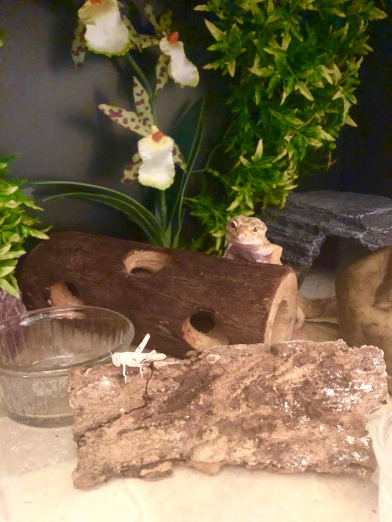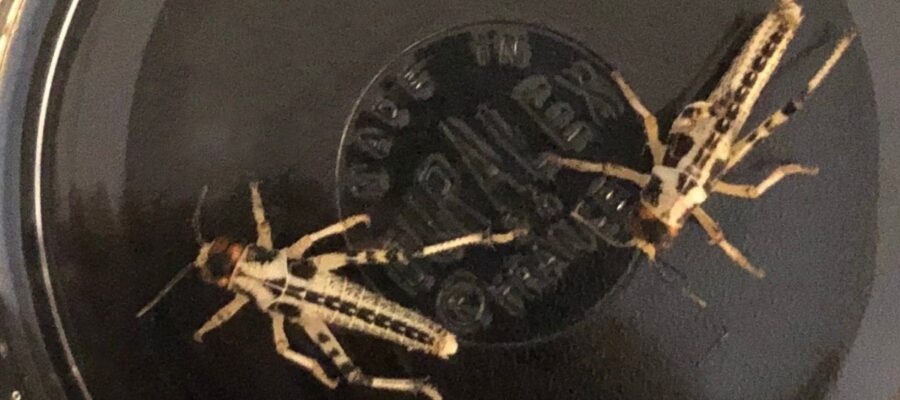It’s really important to feed your geckos a varied diet of live food, because each different insect offers different nutrition and benefits, and also it’s nice for your geckos to have some variety, as their tastes and preferences can change as they age.
Today in my feeder insect review, I’ll be discussing locusts, which are a a type of short-horned grasshopper.
For some frequently asked questions I receive around my leopard geckos’ diets, please see my Leopard Gecko Feeder Insects FAQ post.
Locust care
Locusts tend to come in a tub or a thick, sealed bag, with egg create-like bits of cardboard for them to hide under. You can also buy or make crates for them, but I just tend to leave them in the enclosure they arrive in, because they’re usually eaten fairly quickly and this housing seems fine for them.
 In terms of food, I give them fresh vegetables, such as lettuce, spinach, carrots or celery, which also gives the locusts adequate hydration, but alternatively you can buy pre-mixed bug grub to gutload the insects with and give them some bug gel for their hydration.
In terms of food, I give them fresh vegetables, such as lettuce, spinach, carrots or celery, which also gives the locusts adequate hydration, but alternatively you can buy pre-mixed bug grub to gutload the insects with and give them some bug gel for their hydration.
You don’t need any additional substrate for locusts, but it’s important to take out any old food and keep the enclosure well-ventilated to prevent mould forming.
I find locusts very low maintenance in terms of their upkeep, and they stay alive for ages as long as they’re not fed to the geckos!
The only problem with looking after them is they can jump. They’re nowhere near as jumpy as I expected, and don’t jump more than 50cm (from what I’ve seen!) but this can be prevented by putting them in the fridge 30 minutes before feeding time, or by removing their hind legs (I can’t bring myself to do this, but if you hold their back legs, they will eject them).
To feed them to my geckos, I just let them loose in the vivarium and watch my geckos hunt them, however you can also feed them to your geckos using long tweezers. Even though my main photo on this post shows locusts in a feeding dish, I never use this method to feed them, I just did this to be consistent with my other feeder insect cover photos!
Nutrition
Locusts contain much more protein (50-60%) than fat (12%) and also various nutrients, most importantly phosphorus and traces of calcium.
However , it is important that locusts are dusted with calcium powder, especially if these are being used as a staple feeder. This can be done by putting them in a bag, spraying them with water, and shaking with some calcium powder, and will give the locusts a lovely white coating.
If you’re concerned about the locusts jumping everywhere, you can put them in the fridge 30 minutes before a feed, and they are more docile and can easily be picked up.
I use these as a staple feeder, but as part of a varied and balanced diet, alongside plenty of other insects.
They don’t smell or make a lot of noise
Locusts do not smell, and the only noise you can hear from them is if they hop around, but this is so minimal I usually can’t hear a thing.
They move lots
I don’t know if this is a pro or con – for my female leopard gecko who is a much better hunter, the visual stimulation these insects provide is fantastic, however my male is less lucky. He’s very lazy, and locusts can often get away from him and I’ll find dead/ hiding locusts around his vivarium days after he was given them.
As already mentioned, if you want to prevent them from moving as much, put them in the fridge for 30 minutes and they’ll be easier for you to handle (they’ll barely move) and for your leopard gecko to catch.
Cost
They’re not terribly expensive. I can get 50 large locusts for £8 in the UK, and they live for a long time. My only issue is the sizes can vary so much, and sometimes there are huge locusts which are far too big for my leopard geckos to handle, so some do go to waste.
A small tub of about 20 locusts in my pet store is about £3-4 and I can rely on the sizes much more when I buy them in person, but this option tends to be more expensive.
Nutritional profile: 6/10Smell/ Noise: 8/10
Movement: 9/10
Ease of containing: 2/10
Cost: 7/10




